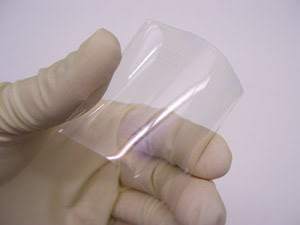Potential applications include e-paper and e-books.
Michael A. Greenwood, News Editor
As the push to create optically transparent and mechanically flexible LED displays for the next generation of portable electronic devices continues, researchers are looking for ways to conceal the internal electronics that drive these screens.

Researchers have created a transparent active-matrix organic LED, with nanowire transistors as the active channel material. Courtesy of Tobin J. Marks.
Full-colored active-matrix organic LED (OLED) displays have shown promise in this area, but they need transparent transistor circuitry to make them viable. Current transistor technology is either optically opaque, and thus not well suited for transparent displays, or it requires a large transistor area, which creates issues with brightness resolution and power efficiency.
To avoid these obstacles, investigators used transistors with indium oxide nanowires as the active channel material in their active-matrix OLED display. The approach potentially offers the desired transparency in addition to high performance, said researcher Tobin J. Marks of Northwestern University in Evanston, Ill. The research was a collaborative effort between the Marks group and the teams of David B. Janes at Purdue University in West Lafayette, Ind., and of Chongwu Zhou at the University of Southern California in Los Angeles. The results were published in the Dec. 11, 2007, ASAP Edition of Nano Letters.
Transparent transistors can be placed in front of or behind the OLED emissive region on pixels in a flexible display, instead of being positioned around the edges. This allows the emissive area to be maximized. Lightweight, transparent and flexible displays are being looked at for a number of emerging applications such as e-paper, e-books and displays that are built into car windshields.
The team fabricated its transparent active-matrix OLED by depositing a layer of SiO2 onto a glass substrate. They added a thin film of indium tin oxide and patterned it to create the bottom gate electrodes. A layer of organic self-assembled nanodielectric was applied and contact holes were formed as anode openings for the OLED units. At this point, the researchers incorporated indium oxide nanowires, each with an average diameter of 50 nm and a length of 5 μm, into the design. Transparent conductors were used for the source and drain contacts. The fabrication of the OLED was completed with the deposition of polymer layers and a top-contact metallization.
The finished display product was fashioned into a 2 × 2-mm array (containing 300 pixels and 900 nanowire transistors) and achieved a brightness of 300 cd/m2 at ~10 V and an optical transmittance of ~40 percent. Marks said that the demonstration-level OLED limited the transparency. The team’s goal is to achieve transmittance rates of 80 percent or greater.
Besides performance, Marks said that the nanowire-based active-matrix OLEDs have the benefit of being relatively easy to fabricate. Conventional low-temperature polysilicon thin-film transistor arrays require from eight to 10 photomasks, a time-consuming process that drives up production costs. The nanowire approach, by comparison, requires only four photomasks, he said.
The researchers plan to build future arrays on plastic substrates and to construct larger displays.